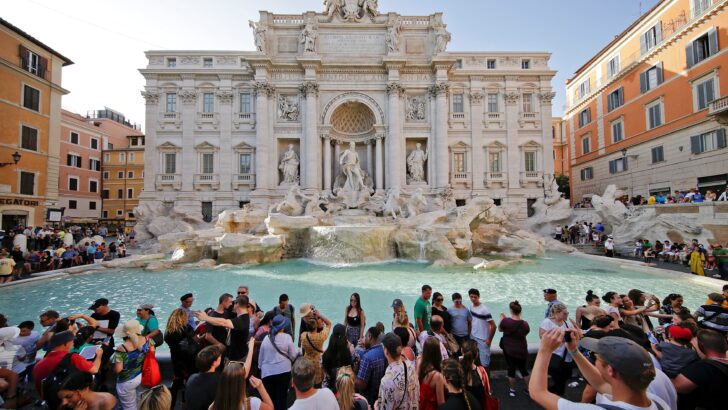The Fontana di Trevi in Rome is being restored – like so many sights in the Eternal City. However, tourists do not have to do without the coin toss.
The Fontana di Trevi in the historic centre of Rome has been pumped dry for renovation. The baroque masterpiece is to be given a footbridge by the end of the year, allowing around 12,000 visitors a day to cross the almost 50 metre wide basin and view the marble façade populated by sea creatures up close, according to Italian media reports.
A white basin with a light blue background has now been installed in front of Rome’s largest fountain for the traditional coin toss over the shoulder, which, according to legend, ensures a return to the Eternal City. On social media, the rectangular “paddling pool” in front of the monumental building caused much ridicule. Others are happy to at least be able to see the fountain through transparent walls, while many monuments in Rome are currently disappearing behind opaque construction fences. “Rome is always beautiful, with or without water in the Trevi Fountain,” said a tourist from Buenos Aires to the newspaper La Repubblica.
Rome’s city council is financing the restoration and cleaning work with funds from the “Caput Mundi” project launched in 2022, which is also implementing hundreds of measures at cultural and archaeological sites with a view to the Holy Year 2025. Around 32 million visitors are expected in Rome for the major Catholic event.
The Trevi Fountain, designed by Nicola Salvi (1697-1751) on behalf of Pope Clement XII, was completed in 1762 after 30 years of construction. On the 49 metre wide and 26 metre high marble and travertine façade, numerous water creatures cavort around the sea god Oceanus.
According to Rome’s mayor Roberto Gualtieri, the planned walkway will also serve to count the number of visitors. Depending on the results, he does not rule out the possibility of limiting access to the fountain steps in the future and charging an entrance fee of around two euros from 2025. The coins that end up in the Trevi Fountain every year have been collected regularly since 2001 and donated to the local Caritas organisation.


 Tourists stand at Rome's Trevi Fountain Aug. 2, 2017. (CNS photo/Max Rossi, Reuters) See TREVI-COINS-CARITAS Jan. 14, 2019.
Tourists stand at Rome's Trevi Fountain Aug. 2, 2017. (CNS photo/Max Rossi, Reuters) See TREVI-COINS-CARITAS Jan. 14, 2019. 